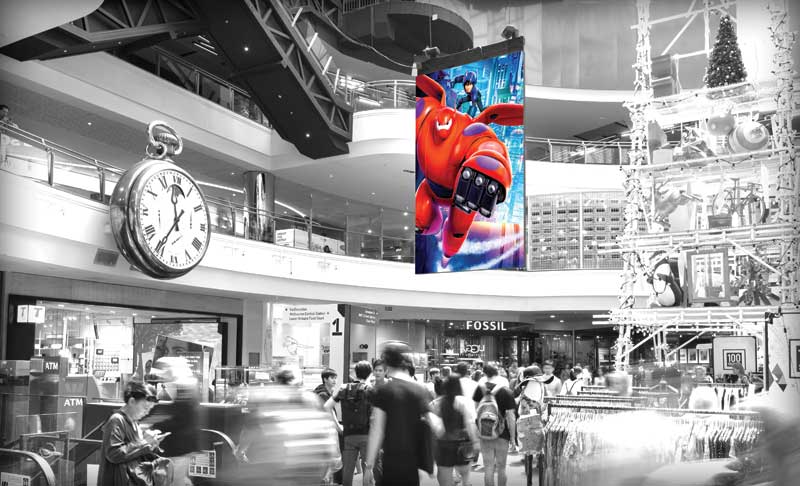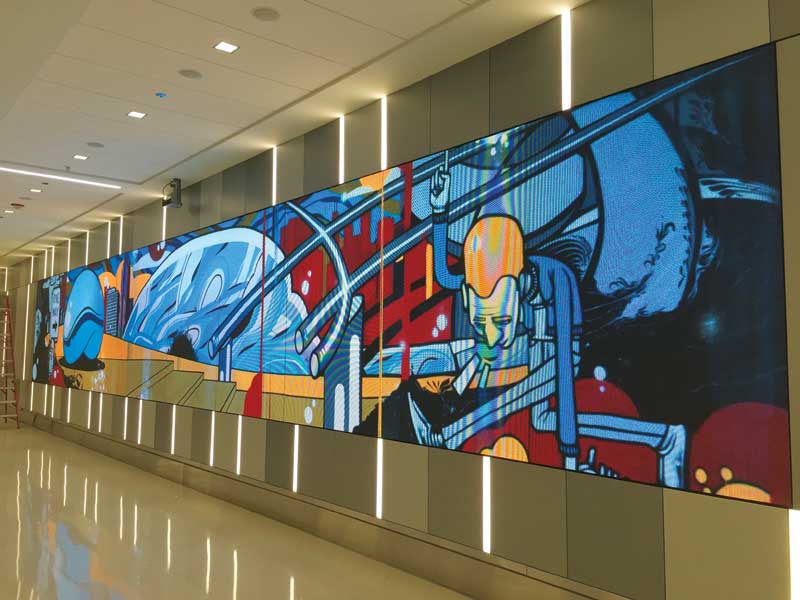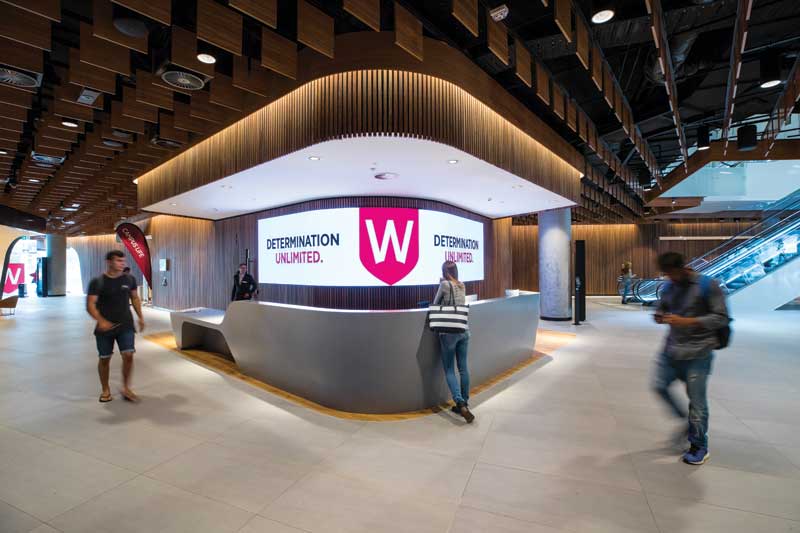Digital Signage: How to optimize displays and content to stand out in a crowd
by all | 8 February 2018 2:25 pm
 [1]
[1]Images courtesy Nanolumens
By Joe’ Lloyd
Digital signage may seem like a magical technology, but it is only as effective as the content it displays, whether its purpose is to convey information, incite curiosity or inspire an emotional response. At the same time, the design and manufacture of light-emitting diode (LED) display hardware will directly affect the quality of the content’s on-screen appearance. Not every display will showcase content at the same level of precision, after all, just as not all content is created with the same level of care.
There are actually three fundamental steps involved in creating an effective LED display:
- Build high-quality hardware.
- Create unique content.
- Establish when and where the content will be seen.
Not all displays are created equal
Audiences viewing content on an LED display that appears blotchy, low-quality or ‘not quite right’ will quickly lose interest. Instead of focusing on the substance of the content, they will pay attention only to its superficial appearance.
This is a significant problem. Digital signage content is expensive to produce. No one can afford to waste resources on showing beautifully designed content on a lacklustre display.
The main reason the visual quality of content can vary from one display to another is the fact the displays are not always built under the same conditions or to the same standards. Some manufacturers pride themselves on producing high-quality LED displays, but others cut corners to reduce costs, in the hope of drawing in customers who only focus on the sticker price.
To make sure an LED display planned for installation will showcase content exactly as desired, it is worthwhile to investigate certain elements of its manufacturer’s production process. This means starting at the very beginning, when the pixels of a display are first built.
 [2]
[2]Large-format LED displays are becoming more common in busy areas because their images can be viewed from a broad range of angles and distances.
The sum of their parts
Just as a chain is only as strong as its weakest link, so too is a display only as strong as its weakest LED.
While the individual LEDs within an array may seem identical to the naked eye, they are not manufactured identically. Rather, each LED created in a given production run will exhibit tiny variances from the others in its batch, despite the fact they were all made using the same materials.
For this reason, manufactures sort newly created LEDs through a classification process that groups those that are alike. This sorting process is referred to as ‘binning.’ Generally, the two criteria used for binning are (a) colour wavelength and (b) forward voltage.
These two metrics determine the specific colour profile and brightness level of an LED. The narrower the parameters for each group, the more similar each LED’s performance will be to that of the other LEDs with which it is binned.
Displays built with LEDs from the same bin will exhibit a more cohesive appearance for content, whereas those built with LEDs from diverse bins can appear spotty and interrupted. On a meticulously binned display, for example, the image of a dark black suit will appear uniform, but on a display built with blended pixels from different bins, different shades of black and grey can appear in different parts of the image.
Due to the outsized impact of LED inconsistency on the appearance of digital signage content, the precision which binning is performed has become one of the primary differentiators of quality in today’s market. The companies that source the best and most consistent components are those that manufacture the highest-quality finished products.
 [3]
[3]Using LEDs as building blocks means a display can be any size, without bezels interrupting large images.
Hiding defects
Lower-end display manufacturers buy LEDs from across their suppliers’ entire production run and blend them together. To help remedy inconsistencies, many of them perform a ‘smoothing’ process, referred to as calibration.
While this process improves the consistency of a display’s appearance, it does so at the expense of brightness, resulting in a proportional decline in greyscale uniformity. It is this uniformity that defines a display’s colour depth, i.e. how well it differentiates between varying shades of the same colour within the same content.
In a calibrated display that has lost greyscale uniformity, if the aforementioned image of a dark black suit was showcased next to a grey suit, then the two advertised products could appear to be the same colour as each other. This of course would be a problem for the retailer offering those different shades of clothing.
Differences between poorly binned LEDs and the reduced visual performance of calibrated displays will be most noticeable for audiences viewing content from shorter distances. Given many LED arrays are now being installed indoors, where they are seen up close, the process of binning has become all the more crucial.
Standing out
Once there is a clear understanding of how an LED-based display will perform in the field, it is time to turn to the process for generating the content it will showcase.
As mentioned, this content needs to stand out. People are bombarded with thousands of digital messages every day and only the best of the best will stick in their consciousness. So, while the right display in the right location grants a strong opportunity to grab consumers’ attention, the onus falls first onto content creators and network managers to earn that level of attention.
Whenever possible, graphics should be used instead of text, as they are better at capturing attention and conveying a message quickly. Where text must be included, it should be in large font sizes to optimize its legibility.
The content development process should answer the following questions:
1. Who is the audience?
Messaging should be properly targeted to its audience, bearing in mind demographic data relating to age and gender, as well as whether viewers of the digital signage will be new or repeat customers.
2. What is the installation’s purpose?
Once it has been determined if the project’s purpose is to display branding, share special offers, create atmosphere or meet another goal, then digital signage content can be developed accordingly.
3. How frequently will content be viewed?
The more frequently a screen will be viewed by its audience, the more its content should be varied, so people will remain engaged by it.
4. For how long will it be viewed?
For a captive audience, such as a lineup at a bank, content should change frequently. For a display that will be viewed only in passing, on the other hand, the emphasis should be placed on eye-catching content.
5. Who will create the content?
Digital signage content creation may be handled by in-house teams or outside vendors, such as content licensors, creative agencies or individual designers.
 [4]
[4]Figure 1
Choosing colours
A study by the Institute for Color Research found people make lasting judgments about content, with a disproportionate share of these judgments dictated by the colours used to convey the content’s message. Well-designed digital signage content reflects the implications of colour research, with a strategy crafted to attract attention, spark an emotional response and call the audience to action.
To determine this strategy, it is recommended to start by choosing a pair of colours opposite each other on the standard 12-spoke wheel (see Figure 1). This will provide a high degree of contrast, ensuring the content will stand out.
Next, deploying these two colours in a ratio of roughly 7:3 will help establish one as dominant and the other as a secondary accent. Finding the right balance for the colour scheme is imperative in creating professional, direct and well-focused content for digital signage. This is why it is worthwhile to spend time choosing the right colours in the first place.
Structuring the strategy
‘Content is king’ in the world of digital signage because it not only promotes a brand, but also sells a story. With shrinking attention spans, a well-structured strategy is key to a successful implementation.
Today’s digital signage networks can use ‘beacons’ to identify audiences and trigger content specific to their interests. When an individual is treated to a more personalized experience, he/she feels more valued by the organization behind the content and is likely to see it in a more favourable light.
Another way to use content to speak directly to individuals is interactivity. This option allows audiences to custom their experience on their own. By giving them the means to participate, the content will foster a stronger connection with the brand.
Optimizing viewing
With scrupulously binned LEDs and exceptional digital signage content, the next step is to determine the optimal location. This may be easier than it sounds, given the nature of the technology.
 [5]
[5]Text should be presented in large font sizes to optimize its legibility.
Digital signage network managers are increasingly choosing to install large-format LED displays because, compared to other technologies, they are brighter and better
at attracting attention. Further, they are uniquely equipped to engage audiences from an array of viewing distances and angles.
Indeed, the content on an LED display can be viewed from almost anywhere. The key is to optimize the display for off-axis viewing, i.e. from the side, away from centre. This is especially important when content is viewed while the audience is in motion, e.g. walking past the display.
If a display only has an off-axis range of 90 degrees, i.e. 45 degrees from centre in each direction, then people walking past it will soon notice the content is no longer clearly visible. Other displays can provide an off-axis range of 160 degrees, i.e. 80 degrees from centre in each direction, for four times the total visibility (see Figure 2). The longer people can see the content, the more likely it is to make an impression.
Configuring content
With a customized system, rather than an off-the-shelf screen, the display can be built with non-standard dimensions to fit a specific space for a specific purpose. Using LEDs as building blocks means a digital display can be any shape or size. The standard screen aspect ratio of 16:9 is appropriate for generic content, but the best fit for a given application may be completely different, from a square screen to one that is far wider than it is high. The content can be configured or ‘mapped’ accordingly.
The resolution of an LED display can be defined by its number of pixels. The threshold for a high-definition (HD) display, for example, is 1,920 x 1,080 pixels, which reflects the aforementioned 16:9 ratio. It is entirely possible, however, for a display to represent different dimensions, in which case the content will need to be adjusted to those parameters.
Joe’ Lloyd is vice-president (VP) of global marketing for NanoLumens, which manufactures LED-based digital displays. For more information, visit www.nanolumens.com[6].
- [Image]: https://www.signmedia.ca/wp-content/uploads/2018/02/melbournecentral_australia.jpg
- [Image]: https://www.signmedia.ca/wp-content/uploads/2018/02/Britomart-escalator-sides-high-res-0882.jpg
- [Image]: https://www.signmedia.ca/wp-content/uploads/2018/02/Prudential__ChicagoIL__3.jpg
- [Image]: https://www.signmedia.ca/wp-content/uploads/2018/02/Colour-Wheel.jpg
- [Image]: https://www.signmedia.ca/wp-content/uploads/2018/02/WSU_nanolumens_2017-3.jpg
- www.nanolumens.com: http://www.nanolumens.com
Source URL: https://www.signmedia.ca/how-to-optimize-displays-and-content-to-stand-out-in-a-crowd/